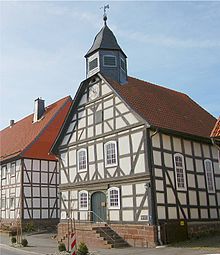Schöneberg (Hofgeismar)
|
Schöneberg
City of Hofgeismar
Coordinates: 51 ° 31 ′ 12 ″ N , 9 ° 25 ′ 9 ″ E
|
|
|---|---|
| Height : | 182 m above sea level NHN |
| Residents : | 550 |
| Incorporation : | December 31, 1970 |
| Postal code : | 34369 |
| Area code : | 05671 |
Schöneberg is a street village in the Kassel district in northern Hesse with 550 inhabitants (as of 2015). Since the Hessian regional reform in the early 1970s, Schöneberg has been a district of the nearby town of Hofgeismar .
geography
Schöneberg lies to the west on the edge of the Reinhardswald . The federal road (B 83) from Kassel to Bremen runs through the village.
history
Castle
The protective castle Schöneberg on the 323 m high mountain of the same name, west of today's village, which was built in the early 12th century , also belonged to the secular power of the Archbishops of Mainz in the area of Diemel and Upper Weser .
Village
The village of Schöneberg was founded for religious refugees from France in 1699. In the 17th century, Landgrave Karl von Hessen gave them new settlement space in the area around the city of Hofgeismar, after they were replaced by the Edict of Fontainebleau and the repeal of religious freedom in France Lost their homeland in 1685. Also here were Huguenot and Waldensian refugees a new home, 1698 on the orders of Louis XIV. Had been expelled. After 1698, after Waldensians were expelled from the French national territory (e.g. Orpierre ) and from Piedmont , Waldensian communities also formed in other areas of Germany.
The village of Schöneberg came into being after Landgrave Karl had designated a place for the construction of a "colony" in the area of the former village of Büngheim (already mentioned in a document in 965), the construction of which began in 1700. Paul du Ry , who - also a Huguenot religious refugee - was appointed court architect by Landgrave Karl in 1685 was responsible for the local planning .
The list of the founding families of Schöneberg names 24 families. Due to the high child mortality rate at the time, their number did not change significantly until the census in 1779. The Schöneberg civil status list of 1779 names a total of 124 people in 28 families.
The main livelihood of the village population was agriculture. Over the years, however, a brickworks, some pottery and other handicraft businesses, including a stocking maker, two tailors, two shoemakers and a soap maker, were built in Schöneberg.
The old Bremer Poststrasse, which originally ran through the neighboring town of Hümme , was passed through Schöneberg from 1730, obviously to connect the newly created Bad Gesundbrunnen near Hofgeismar . This may also have had an impact on the development of the village population. In contrast to the village of Kelze , which was founded around the same time , in Schöneberg there were 16 French households with 76 people and 12 German families with 48 people already living in Schöneberg in 1779, before the special status of the villages founded by French religious refugees was completely granted in 1822 by landgrave decree was repealed.
On December 31, 1970 Schöneberg was incorporated into the city of Hofgeismar.
church
The half-timbered church was built in 1705. The pastoral care of the community was carried out, as in the "Colony" Carlsdorf , by Pastor David Clément until his death in 1725. Clément had been pastor of the French Reformed community at the Neustädter Church in Hofgeismar since 1686 . The organ was built in 1810 by the organ builder Johann Georg Oestreich from Oberbimbach , was originally in Lingelbach near Alsfeld, later in Rothenditmold and has been in the Schöneberg Church since 1965. It was restored in 1991 by the Schmid company from Kaufbeuren.
literature
- Friedrich Bleibaum (editor): District Hofgeismar (= Handbook of the Heimatbund for Kurhessen, Waldeck and Upper Hesse , vol. 3). Oberhessische Presse, Marburg / Lahn 1966, p. 192.
- Jochen Desel : French Villages: 300 Years of Kelze and Schöneberg , Volume II: German Immigrants 1669–1779 . Association for Hessian History and Regional Studies Kassel 1834, branch association Hofgeismar, Hofgeismar 1999.
- Rudolf Knappe: Medieval castles in Hessen. 800 castles, castle ruins and fortifications. 2nd Edition. Wartberg-Verlag, Gudensberg-Gleichen 1995, ISBN 3-86134-228-6 .
Individual evidence
- ↑ Hofgeismar → Facts and Figures → Inhabitants ( Memento of the original dated December 3, 2016 in the Internet Archive ) Info: The archive link was inserted automatically and has not yet been checked. Please check the original and archive link according to the instructions and then remove this notice. (Main and secondary residences) , as of June 30, 2015, accessed on November 30, 2016, at hofgeismar.de
- ^ Federal Statistical Office (ed.): Historical municipality directory for the Federal Republic of Germany. Name, border and key number changes in municipalities, counties and administrative districts from May 27, 1970 to December 31, 1982 . W. Kohlhammer GmbH, Stuttgart and Mainz 1983, ISBN 3-17-003263-1 , p. 398 .
- ↑ https://www.hugenottenmuseum.de/museum/hugenottenorte.php
- ↑ https://www.ekkh.de/gemeinden/schoeneberg.php
Web links
- Official website of the city of Hofgeismar
- "Schöneberg, District of Kassel". Historical local dictionary for Hessen. In: Landesgeschichtliches Informationssystem Hessen (LAGIS).
- Schöneberg on the homepage of the Huguenot Museum in Bad Karlshafen

